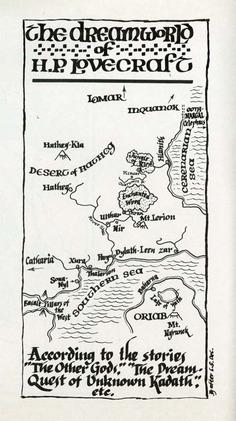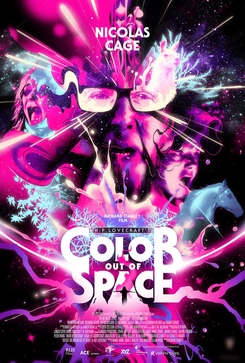
Howard Phillips Lovecraft was an American writer of weird, science, fantasy, and horror fiction. He is best known for his creation of the Cthulhu Mythos.

The Necronomicon, also referred to as the Book of the Dead, or under a purported original Arabic title of Kitab al-Azif, is a fictional grimoire appearing in stories by the horror writer H. P. Lovecraft and his followers. It was first mentioned in Lovecraft's 1924 short story "The Hound", written in 1922, though its purported author, the "Mad Arab" Abdul Alhazred, had been quoted a year earlier in Lovecraft's "The Nameless City". Among other things, the work contains an account of the Old Ones, their history, and the means for summoning them.

Cthulhu is a fictional cosmic entity created by writer H. P. Lovecraft. It was introduced in his short story "The Call of Cthulhu", published by the American pulp magazine Weird Tales in 1928. Considered a Great Old One within the pantheon of Lovecraftian cosmic entities, this creature has since been featured in numerous pop culture references. Lovecraft depicts it as a gigantic entity worshipped by cultists, in the shape of a green octopus, dragon, and a caricature of human form. It is the namesake of the Lovecraft-inspired Cthulhu Mythos.

In the Mouth of Madness is a 1994 American supernatural horror film directed and scored by John Carpenter and written by Michael De Luca. It stars Sam Neill, Julie Carmen, Jürgen Prochnow, David Warner and Charlton Heston. Neill stars as John Trent, an insurance investigator who visits a small town while looking into the disappearance of a successful author of horror novels, and begins to question his sanity as the lines between reality and fiction seem to blur. Informally, the film is the third installment in what Carpenter refers to as his "Apocalypse Trilogy", preceded by The Thing (1982) and Prince of Darkness (1987).

The Darkest of the Hillside Thickets is a rock band from Chilliwack, British Columbia, Canada. Their music largely consists of often tongue-in-cheek homages to the works of H. P. Lovecraft, specifically the Cthulhu Mythos.

At the Mountains of Madness is a science fiction-horror novella by American author H. P. Lovecraft, written in February/March 1931. Rejected that year by Weird Tales editor Farnsworth Wright on the grounds of its length, it was originally serialized in the February, March, and April 1936 issues of Astounding Stories. It has been reproduced in numerous collections.

The Dream Cycle is a series of short stories and novellas by author H. P. Lovecraft (1890–1937). Written between 1918 and 1932, they are about the "Dreamlands", a vast alternate dimension that can only be entered via dreams.

"Pickman's Model" is a short story by H. P. Lovecraft, written in September 1926 and first published in the October 1927 issue of Weird Tales.

Lovecraftian horror, also called cosmic horror or eldritch horror, is a subgenre of horror, fantasy fiction and weird fiction that emphasizes the horror of the unknowable and incomprehensible more than gore or other elements of shock. It is named after American author H. P. Lovecraft (1890–1937). His work emphasizes themes of cosmic dread, forbidden and dangerous knowledge, madness, non-human influences on humanity, religion and superstition, fate and inevitability, and the risks associated with scientific discoveries, which are now associated with Lovecraftian horror as a subgenre. The cosmic themes of Lovecraftian horror can also be found in other media, notably horror films, horror games, and comics.

The Shadow Out of Time is a novella by American horror fiction writer H. P. Lovecraft. Written between November 1934 and February 1935, it was first published in the June 1936 issue of Astounding Stories. The story describes time and space travel by mind transfer, where a person in a given place and time can switch bodies with someone who is elsewhere or elsewhen. As with other Lovecraftian works, this story features otherworldly alien beings that are not simply variations on humans or other familiar terrestrial animals.
"The Dreams in the Witch House" is a horror short story by American writer H. P. Lovecraft, part of the Cthulhu Mythos cycle. It was written in January/February 1932 and first published in the July 1933 issue of Weird Tales.

"Herbert West–Reanimator" is a horror short story by American writer H. P. Lovecraft. It was written between October 1921 and June 1922. It was first serialized in February through July 1922 in the amateur publication Home Brew. The story was the basis of the 1985 horror film Re-Animator and its sequels, in addition to numerous other adaptations in various media.

Zealia Brown-Reed Bishop (1897–1968) was an American writer of short stories. Her name is sometimes spelled "Zelia." Although she mostly wrote romantic fiction, she is remembered for three short horror stories she wrote in collaboration with H. P. Lovecraft.
The H. P. Lovecraft Historical Society or HPLHS is the organization that hosts Cthulhu Lives!, a group of live-action roleplayers for the Cthulhu Live version of Call of Cthulhu. Founded in Colorado in 1984, it is now based in Glendale, California. Their motto is Ludo Fore Putavimus.

Bloodborne is a 2015 action role-playing video game developed by FromSoftware and published by Sony Computer Entertainment for the PlayStation 4. The game follows a Hunter through the decrepit Gothic, Victorian-era–inspired city of Yharnam, whose inhabitants are afflicted with a blood-borne disease which transforms the residents, called Yharnamites, into horrific beasts. Attempting to find the source of the plague, the player's character unravels the city's mysteries while fighting beasts and cosmic beings.

Dark Souls III: The Ringed City is the second and last of the two downloadable content (DLC) packs for the 2016 action role-playing video game Dark Souls III. Released on March 27, 2017, the content pack was developed by FromSoftware and published by Bandai Namco Entertainment. It drew favorable reception from critics, with several seeing it as a fitting end to the Dark Souls series.

The Sinking City is an action-adventure game developed by Frogwares and inspired by the works of horror fiction author H. P. Lovecraft. Set in the fictional city of Oakmont, Massachusetts during the 1920s, the story follows private investigator and war veteran Charles W. Reed as he searches for clues to the cause of the terrifying visions plaguing him, and becomes embroiled in the mystery of Oakmont's unrelenting flooding.

Color Out of Space is a 2019 American science fiction Lovecraftian horror film directed and co-written by Richard Stanley, based on the short story "The Colour Out of Space" by H. P. Lovecraft. It stars Nicolas Cage, Joely Richardson, Elliot Knight, Madeleine Arthur, Brendan Meyer, Q'orianka Kilcher and Tommy Chong. This is Stanley's first feature film since his firing from The Island of Dr. Moreau (1996). According to Stanley, it is the first film in a trilogy of Lovecraft adaptations, which he hopes to continue with an adaptation of "The Dunwich Horror".















